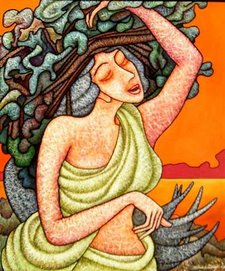While watching yet another venerable financial institution desperately seek a suitor for redemption, I realised that my son would not be back home till 4.30 p.m. since he had Taekwondo after school. Which meant that I had lots of time to go see the mosque that I had been wanting to for a long time..In any case, I figured, it would be a darned sight more interesting than watching another financial institution pay for profligacy & flawed judgements or worse still follies of others...
So packed a bottle of water, some wet tisues and my hat (its an absolute must even though the summer is starting to get over) and sat back listening to some music while my driver navigated the crowded streets of Sayyida Zaynab to get to the mosque.
When you surf the net for Ibn Tulun mosque, it throws up lots of adjectives in description - third largest mosque in the world, oldest mosque in Cairo, third congregational mosque in Cairo, best preserved old mosque etc, etc, etc...



The mosque was constructed on a small hill called Gebel Yashkur, "The Hill of Thanksgiving." One local legend says that it is here that Noah's Ark came to rest after the Deluge, instead of at Mount Ararat.
Built in 879 AD, by Ibn Tulun (was born in Baghdad, the son of a Turkish slave of Mongol origin owned by the Caliph, al-Ma'mun), its survived largely in its original form, and stands out due to two features - a unique minaret and the fact that unlike other mosques in Cairo, its built from bricks and not stones. It is huge, mainly becuase Ibn Tulun built it to accomodate his entire army during Friday prayers! With an area of 26,318 sq m, it is the third largest mosque in the world.

There are lots of stories about who was the architect, how it was built, what influenced it etc..
Western sources claim that an Egyptian Christian was an architect and used the western concept of piers to support the vast span of the roof of the mosque.
However, Islamic historians claim that Ibn Tulun was influenced by the Great Mosque of Sammara (Iraq) as he grew up there. In fact, there are supposed to be many similarities between the two mosques - the material being brick & plaster that had not been used in mosques in Egypt before, the minaret's spiral shape and its location outside the perimeter of the mosque, etc.
Another intresting story goes that Ibn Tulun asked for advice on how to construct a building that would not be destroyed if Cairo was consumed by a fire, or submerged in floods. Fable says that he was adviced to build with plaster, ash and bricks and not use marble as it does not stand up well to fire! Heed their advice he did, and, built this beautiful mosque in rememberance of the one in his hometown...
The vast courtyard is surrounded by four arcaded aisles.



The soffits of the arches are covered in beautifully carved stucco, the first time this medium was used in Cairo. As you walk through the aisles and glance at the carved arches, you realise that no two arches appear to be same...rows after rows of arches have intricate, beautifully carved stucco which add to the delicate atmosphere of the mosque.



The minaret of the Mosque is a famous Cairo landmark, though completely unique in its design and, similar to that of the famous minaret in Samarra. Legend has it that Ibn Tulun himself was accidentally responsible for the design of the structure: supposedly while sitting with his officials, he absentmindedly wound a piece of parchment around his finger. When someone asked him what he was doing, he responded, embarrassed, that he was designing his minaret.
 This minaret, with its only remaining original element being the square base is connected to the mosque by a passage which appeared to be closed right now. Its second story is cylindrical to which were added later, restorations in stone. The original minaret was built of brick. This is Cairo's only minaret with a spiraling external staircase.
This minaret, with its only remaining original element being the square base is connected to the mosque by a passage which appeared to be closed right now. Its second story is cylindrical to which were added later, restorations in stone. The original minaret was built of brick. This is Cairo's only minaret with a spiraling external staircase.
The external walls of the mosque are crowned by what appear to be a chain of motifs, or if you allow your imagination to run wild, a chain of human fgures as if forming a human wall protecting the mosque! I was told by some historian friends that there is a belief that these were so appreciated by medivial European visitors that they became the prototype for Gothic pierced and crested parapets!




2 comments:
Someone told me that women are not allowed to visit mosques in Cairo, but I didn't believe her. What is the truth?
Akinoluna, as far as I know that is not true. I have visited Al Azhar, Sayyida Hussein, Ibn Tulun, Mohammad Ali mosques with no one questioning me or even requiring a male escort.
In Al Azhar, they asked me to cover my head when I went it, as a mark of respect, which I was happy to do, but no one objected even though I was wearing a skirt.
I move around quite a bit in Cairo, visiting a lot of local places, but I have never, till date faced any problems.
Post a Comment